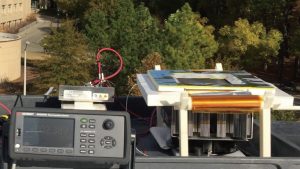
Duke University researchers have created a new device that could help to reduce HVAC energy use. The invention is capable of dual-mode heating and cooling for climate control in buildings, and could be used in cities across the country.
The device employs a mixture of materials science and mechanics that allows it to harness or expel specific wavelengths of light as needed. Rollers attuned to external conditions move a sheet back and forth. This sheet is designed to expose heat trapping materials on one side, or cooling materials on the other side. These materials are designed at nanoscale, allowing the heat trapping material to absorb the sun’s energy and trap ambient heat. Meanwhile, the other side reflects light, reducing the heat which then escapes into space, beyond the earth’s atmosphere.
“I think we are the first to demonstrate a reversible thermal contact, which allows us to switch between the two modes for heating or cooling. This allows the material to be movable while still maintaining a good thermal contact with the building to either bring heat in or let heat out.”
Po-Chun Hsu, assistant professor of mechanical engineering and materials science at Duke and leader of the team behind this device
This technology could prove quite effective in reducing greenhouse gas emissions. While previous efforts have been made to deal with this growing concern, this is the first such device that can handle both hot and cold weather. Such an innovation could help people remain safe and comfortable in buildings while simultaneously reducing harmful emissions.
The sheet created by engineers is made of a metallized polymer composite, which serves as the base. This composite can generate electrostatic force once voltage is applied. The device can therefore stay in contact with the building, transmitting energy while still being able to switch between hot and cold modes.
One portion of the sheet has an ultra-thin layer of silver film. This is covered by a layer of clear silicone; when these two materials are combined, they reflect the sun’s rays, emitting mid-range infrared light. This infrared light can pass through the earth’s atmosphere without interacting with any of the gasses, allowing the light a safe and harmless journey into outer space.
Heating a building is accomplished by using an ultra-thin layer of copper, which is covered by a layer of zinc-copper nanoparticles. These nanoparticles are created with a specific size, and spaced a carefully calculated distance apart from one another. This gives them the ability to trap light onto the surface of the sheet, resulting in an absorption rate of over 93% of the heat from the sun.
Further testing and research is needed, but the engineers behind this device believe this technology could work in conjunction with existing HVAC systems. By combining these technologies, buildings could stay warm or cold as the weather calls for while reducing the negative impact on the environment.
